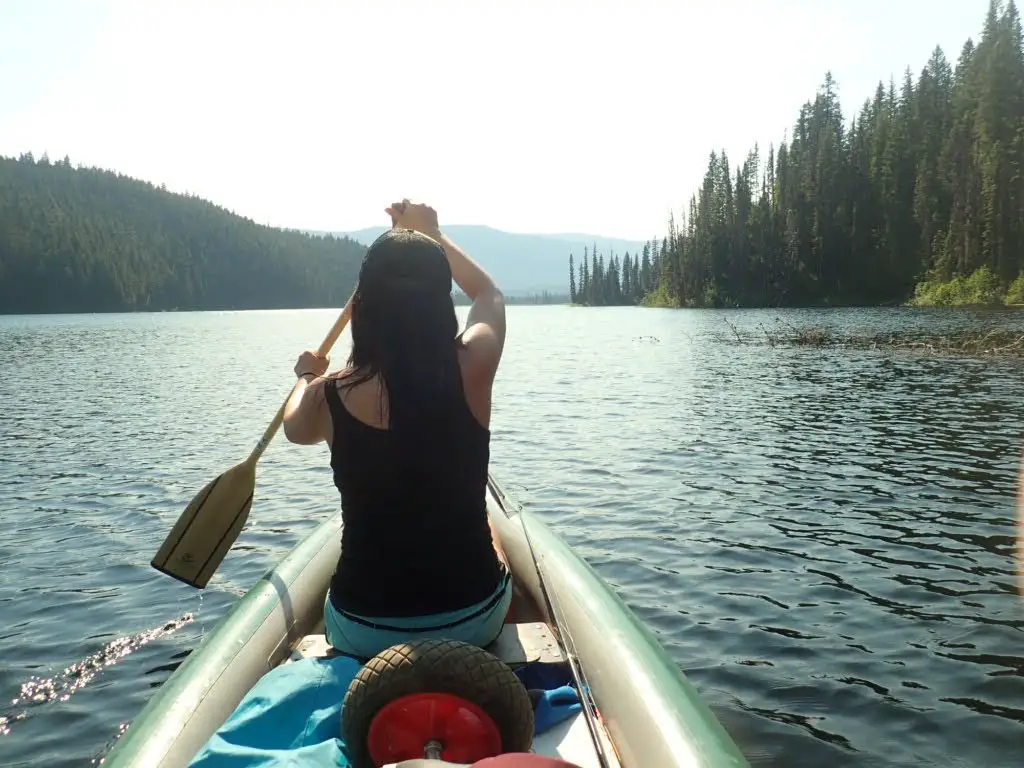Murtle Lake is the largest canoe-only lake in North America. This pristine L-shaped lake – home to some amazing trout-fishing – is located in Wells Gray provincial park – approximately a 7-8 hour drive northeast of Vancouver, near Mount Robson – highest point of the Canadian Rockies. In late-June 2021, during one of the hottest heatwaves in North American history, Jens and I packed up his 1992 non-airconditioned Eurovan to take on the 600KM journey to Murtle Lake for some first-class canoeing, camping and fishing.
This post includes affiliate links. If you make a purchase via one of these links, I may receive a small percentage at no extra cost to you.
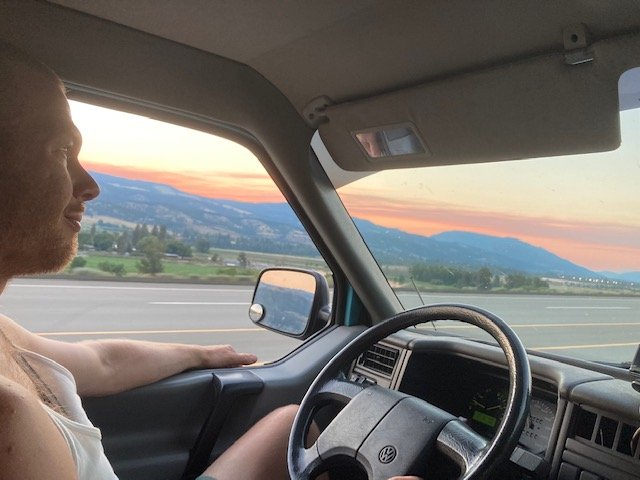
Day 1:
Given it was over 40 degree temperature on our un-airconditioned drive over, we needed an effective cooling strategy for the 600KM drive: cue beautiful BC lakes!
A few days before our epic(ly hot) road trip, I mapped out some lakes along our highway route where we can dive in to cool off every few hours.
Stop 1: Kawkawa Lake at Hope, BC (115km into roadtrip)
Lovely little lake in Hope, BC about a 1.5 hour drive or 115KM from Vancouver. Water is quite clear but the bottom is muddy. Both a grassy and sandy area. Public toilets plus an outdoor shower are available.
Stop 2: Lac Le Jeune, about 30 minutes southwest of Kamloops,BC (320KM into roadtrip)
Beautiful crystal-clear lake with a provincial campground next to it. Lac Le Jeune was approximately about a 2 hour drive from our last lakeside cooling stop at Kawkawa Lake in Hope (or 3.5 hours from Vancouver). We did not stay at the campground, but it looked quite massive, and would be a wonderful place for a family-oriented front country camping vacation. Public washrooms right by the lake with a picnic area and pebbly beach.

Stop 3 (and camping stop for night 1): Barriere Lake, BC, about 20 minutes northeast of the town of Barriere (440km into roadtrip). We camped at East Barriere Lake Recreation site which was a 23km drive on a logging road from the town of Barriere.
Recreation Sites are little known, but wonderful spots available for camping and recreation which are usually available for free or for a nominal fee. Often accessible by logging roads, they usually have ample availability even on busy weekends due to their backcountry nature and less accessible locations. Sites tend to be very basic, like a few clearings for a tent or vehicle, and many will not have toilets or running water. Some sites are very well developed however, with pit toilets and taps with potable water. East Barriere Lake Recreation site is one of the more developed sites with very clean pit toilets and a site manager. Fee per night was $15. While more rustic sites are free, sites like East Barriere will generally charge a small fee.
Day 2:
We woke up to muggy hot morning and after breakfast of bacon, eggs and slow coffees made with Jens’ grandma’s vintage pour over coffee maker inherited and brought over from East Germany, DDR(!); we took our first cooling swim in Barriere Lake, loaded back into the Eurovan and got back on the road towards Murtle Lake.
Despite it being another scorching 40 degree day, we decided we could make it all the way to the Murtle Lake trailhead at Phyllis Lake, about 200km (3 hour drive away) without taking any cooling swim stops – reasoning that we could just jump into Phyllis Lake when we arrived at the trailhead. This was a mistake. The parking lot is situated at a significant elevation from Phyllis Lake and we could not find any suitable trail to reach the lake from the parking area. So we had to forgo our much-desired midday cooling swim. If you need a swim before reaching Murtle Lake – try Elenor Lake in Blue River before taking the gravel road to the trail head.
Set-up and Portage:
As dwellers of one of the most expensive cities in the world, we don’t have much space for hard shelled watercraft. Jens and I both have inflatable kayaks, standup paddleboards, and for this trip we took Jens’ Gumotex Scout Canoe. This inflatable canoe and all its components fold into a duffle bag sized backpack: once set-up, it transforms into a full-sized canoe with seating for three. It also works well for two adults and two small children in the middle. In the water, it tracks relatively well – but not quite as true as a hard shell canoe. Small trade off given its unparalleled portability and small storage footprint.

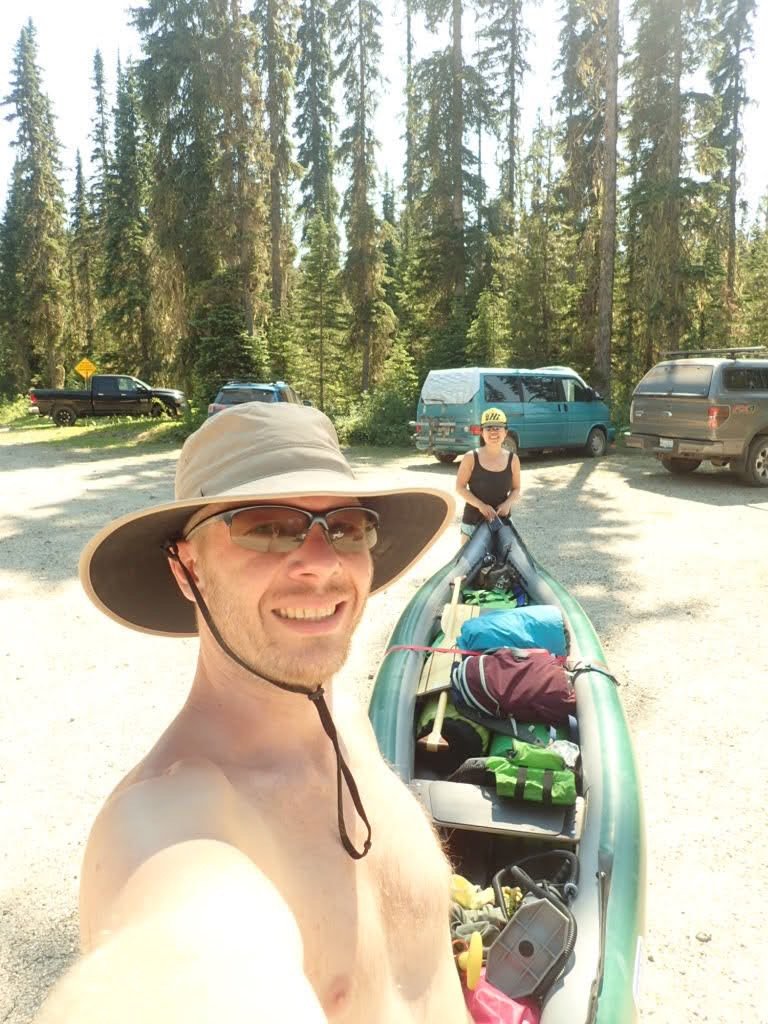
There’s a great canoe rental service that is available for bookings online at https://murtlecanoes.com/make-a-reservation.html. If you make a reservation, your canoe will be ready for pick up at the Murtle Lake Lagoon launch on the date of your arrival – forgoing the need to portage a canoe down the 2.5km trail from the Phyllis Lake trailhead to the boat launch. Gear carts specified for the use of canoe rental customers are available at the parking lot – although we saw plenty of non-renters using the unsecured carts as well.
While the inflatable canoe could have been carried in a backpack on the 2.5km portage, we elected to inflate it, and use it, along with a portable canoe cart, to wheel our gear using the canoe as a gear vessel on the relatively flat gravel trail to the launch site.
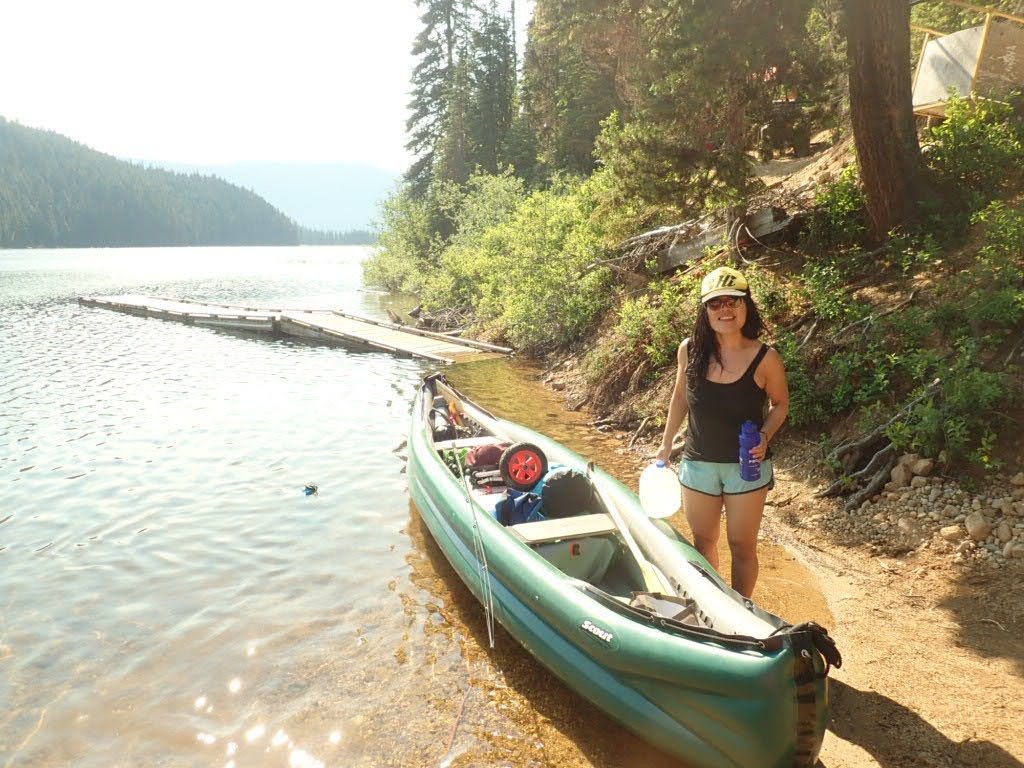
Portaging a canoe and 3 days worth of camping gear is hard work even with the help of a wheeled cart, but doing it during a heat wave made the 2.5km portage even more strenuous. We were elated to finally be able to jump into the crisp clear water at Murtle Lagoon once we completed the portage – which took about 45 sweaty water-break-laden minutes.
You can register and pay your park-use fees at the Murtle Lagoon Launch site. Note: even if you paid for your stay online, you still must physically register your stay once you arrive at the park, as the rangers need to know who has actually arrived in the park for safety reasons. Failure to register your arrival (even if you’ve already paid your fees online) may result in a chase-down and pirate-boarding of your vessel, by the friendly neighborhood park rangers – who will then kindly register your arrival. Not that we know this from personal experience…
There’s a handy canoe cart lock-up at the launch site, so if you bring a bike or cable lock, you can lock your personal canoe carts up at the boat launch rather than bringing it with you. Jens and I did not know this so we carried our cart with us. It was small enough in any case. Something to remember for next time!
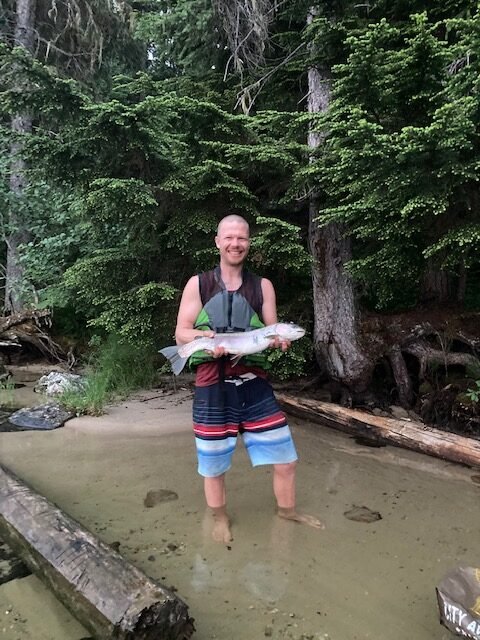
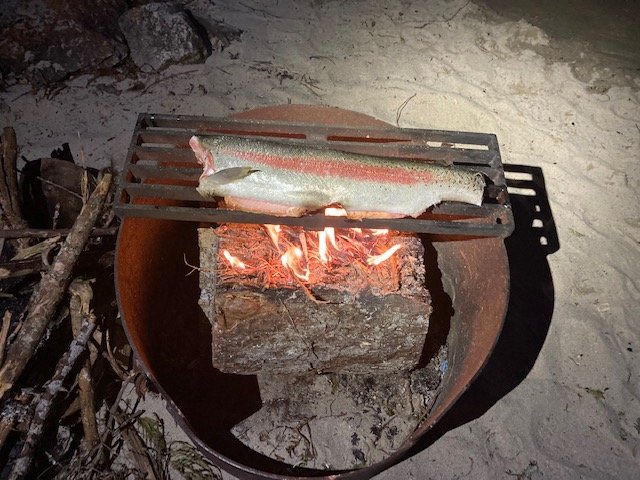
Jens brought his fishing rod along to try our luck at catching some fish. Jens has lived in Canada for nearly 10 years and has caught approximately zero fish in that time (not for lack of trying). My own fish-catching record is similarly dismal. Nonetheless, we threw the line in the water to drag it along as we canoed to our campsite. Within a minute of dropping the line in the water I hear Jens exclaim “I caught a fish!” I thought he was joking until he nearly reeled in a good-sized trout! We had such low expectations of actually catching anything, we didn’t have a plan (or even a net) for if we actually did catch anything! We ended up hooking at least 7-8 fish and reeling in 3 trout (two of which ended up as dinner), and losing the rest because of the lack of a net issue. Despite our lack of any kind of preparation, Jens ended up reeling in a monster 6 pound rainbow trout, in an epic battle which saw the fish full body jumping into the air with the purple-magenta sunset in the background. After passing me the rod to reel the fish closer, Jens then had to manhandle the fish into our canoe with his bare-hands! It was the stuff of manly legend and I stand witness to his epic fish story which will undoubtedly be recounted for years to come.
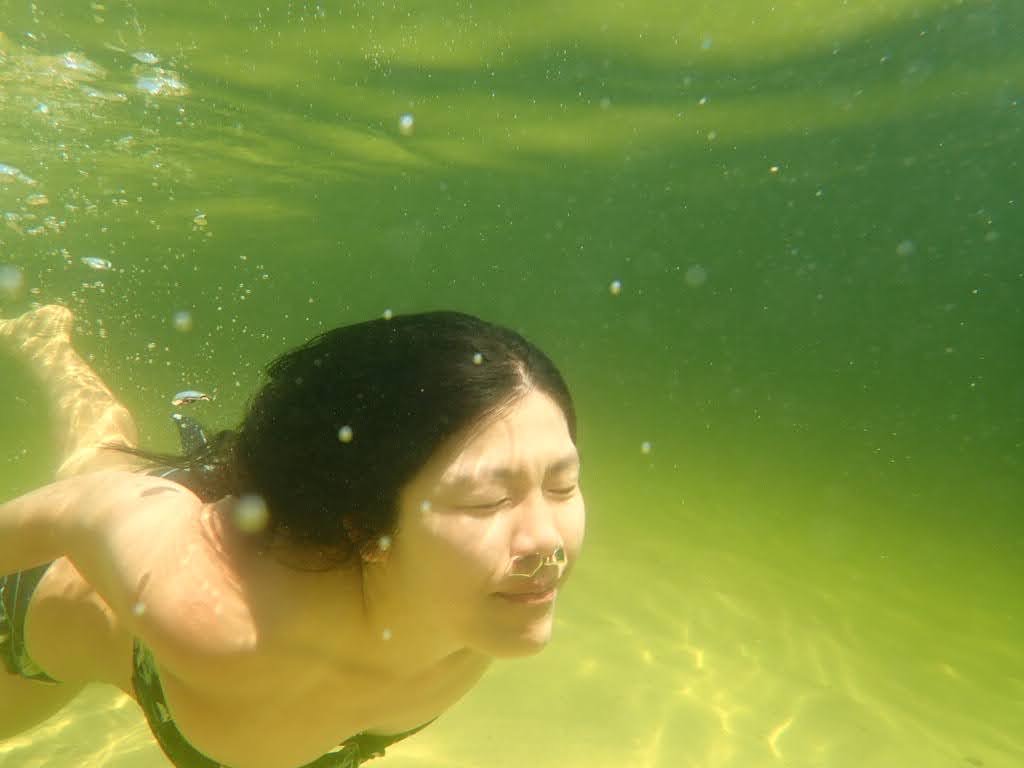
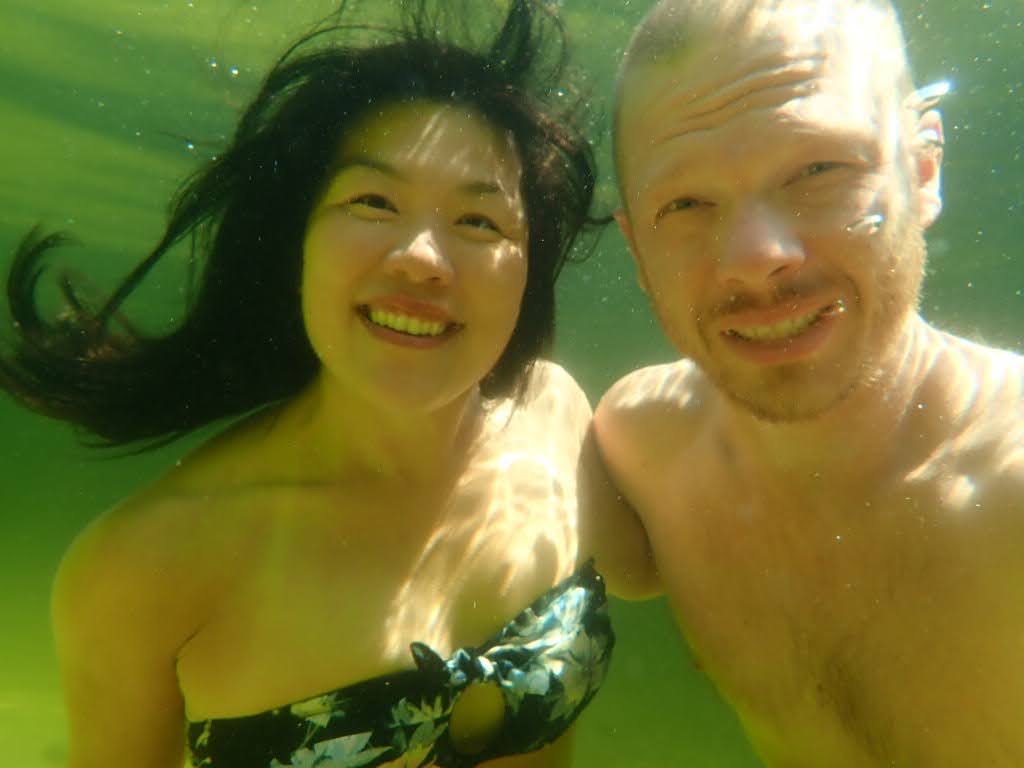

The campsite at Sandy Point was absolutely beautiful! With crystal clear water and a long and shallow white sandbank, it was almost like we found a gorgeous tropical paradise in Canada! There were only 2 sites available when we went, as the 3rd site was underwater from the flooding caused by the heat wave. The two sites available were of a generous size however and very private, with fire pits. You’re allowed to gather firewood, and often, there are piles of pre-cut firewood available to campers for free! We were lucky to arrive the day before the province-wide fire ban was implemented, so we were able to grill our monster trout over the campfire.
One downside of a lake full of big fish is that it’s usually indicative of a healthy amount of insects that keep these fish so well fed. Mosquitos were definitely a major feature of this trip. Shockingly, even the bug spray that kept me bite free in India was not enough to keep the evil buggers away. Thankfully Jens lent me his bug shirt (since I was unfortunately the tasty one to the mozzies), and we pretty much bathed ourselves in bug spray to keep them off. They showed up as the day starts to cool about 2-3 hours before sunset, and cover the tent until the late morning sun causes them to retreat. Don’t forgot a healthy mosquito defense strategy if you choose to visit!

Day 3:
The next morning after the epic fish roast, we had leftover grilled trout and bacon for breakfast, and went off for a paddle around the lake. When we arrived back, the winds had picked up considerably, changing the water from glasslike smooth to angry whitecaps in a rather disconcertingly short period of time. It was a work-out to paddle back to the site in those conditions – do try to do all your paddling before midday – as the afternoon winds can change paddling conditions quite quickly.

Before we left for our paddle around the lake, Jens had packed the remainder of the trout and bacon leftovers in a lidded pot and cleverly stored it in the lake in shallow water secured with rocks on top and around the pot to act as clever make-shift refrigerator. Unfortunately, by time we got back, the lake water had risen and we came back to our fish pot covered in lake water.
“Oh well, we already ate a lot of fish.” I told Jens as I figured the leftovers were inedible. “No, we’re going to make fish chowder!” Jens exclaimed confidently. It took a moment for my brain to understand that Jens was completely serious and still another moment to see the logic in what may seem at first like some kind of joke; but in the end, I saw the beauty of the accidental fish soup idea: we were already using the crystal clear lake water as a water source, so why not? We added some white cheddar to the pot, gave it all a long boil and voila! Delicious accidental fish chowder! Jens claims this fish chowder was his plan all along…
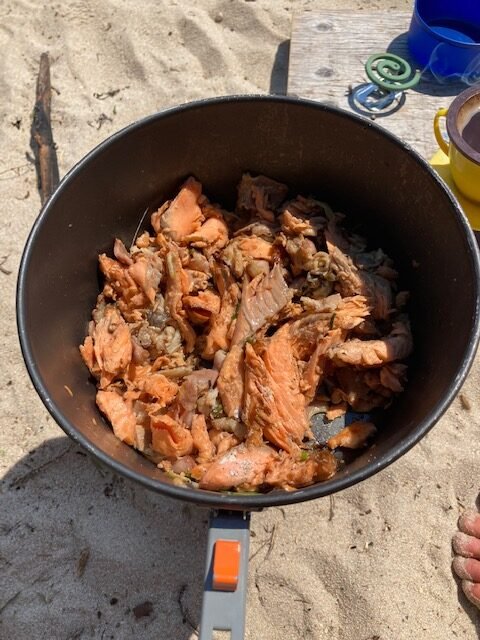
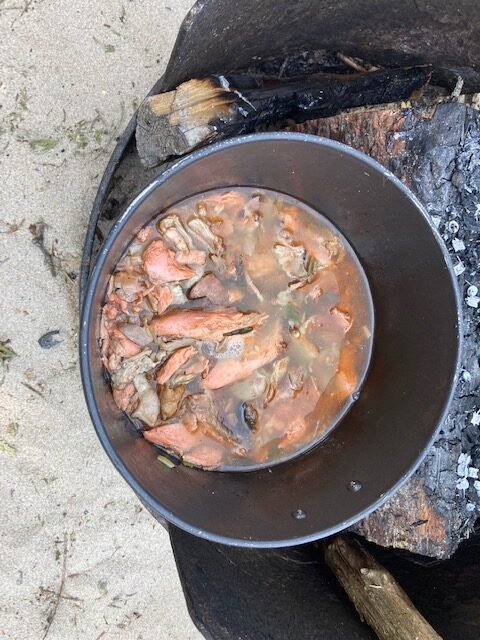
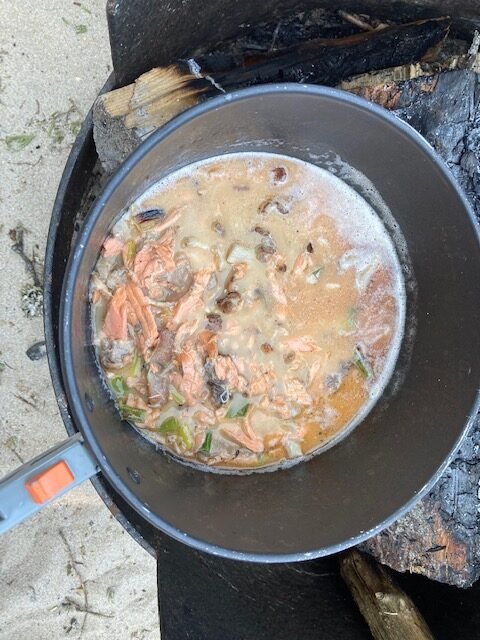
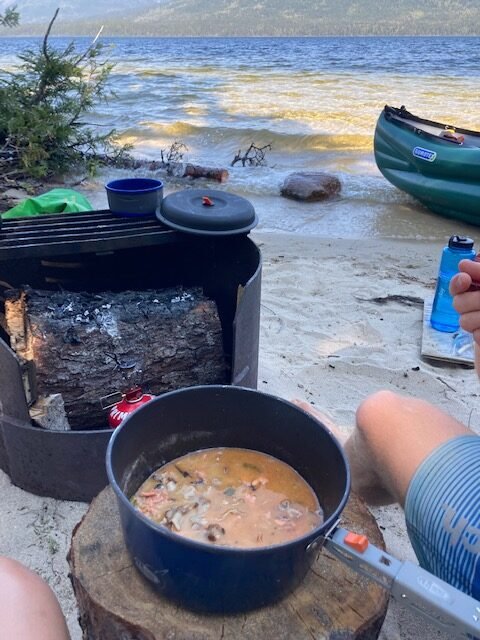
Day 4:
Our original plan was to hike the Berg Lake trail after leaving Murtle Lake, unfortunately the trail was closed due to massive flooding caused by the heat wave, and we did not find out about the closure until we got to Valemount and finally got cell signal.
We decided to camp in Valemount for a few nights before taking a road trip to Jasper and Lake Louise via the Icefields Parkway (topic of a future post) since we were already so close-by.
Our first night in the Valemount area was nothing to write home about. All the campsites were full, but a kindly Park Ranger directed us to a piece of crown land off a side road where we could spend the night given how we were effectively stranded due to the Berg Lake Trail closure.
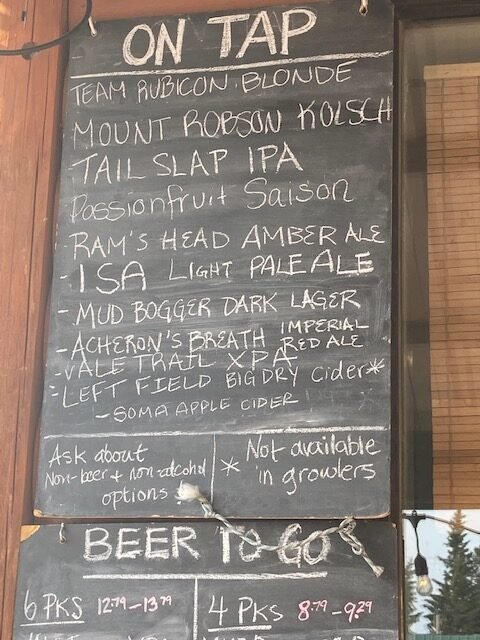

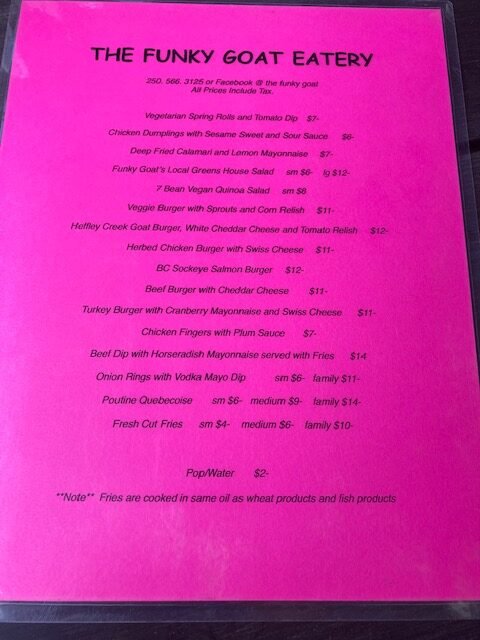
Day 5:
The next day after a breakfast spent with glorious views of Mount Robson in the background and the sights and sounds or rescue helicopters circling the mountain to pick up stranded hikers, we headed down towards Yellowjacket Recreation site on Kinbasket Lake that came recommended to us from a Valemount local.
Jackpot! Yellowjacket Recreation site is one of the most gorgeous campsites I’ve ever had the pleasure to visit! You have a beautiful lake and the majestic Monashee Mountains immediately across from you. Throw in some cold drinks and a heat wave, and you have a proper summer lake day! You can stay in the forested campsite for $15 a night; or you can actually camp free on the crown land right by the lakeside! Hint: free was definitely better in this case!
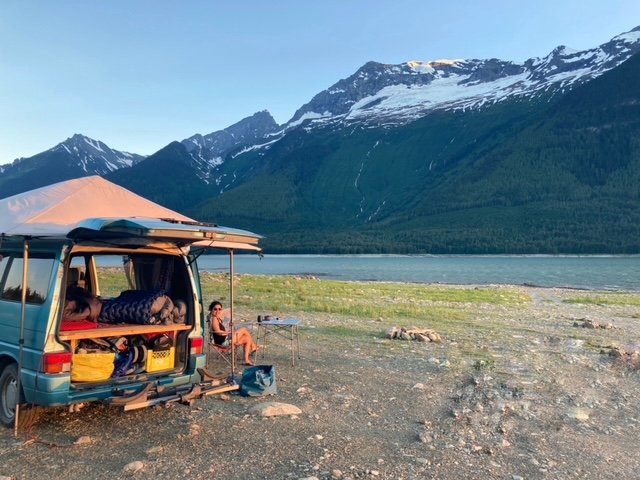
While the historical heat dome had stymied our plans to hike the beautiful Berg Lake Trail, in the end, Jens and I still made this trip one to remember. Camping by the river with the snowcapped Monashee Mountains across from us after a day spent with cold drinks while cooling down ultimate summer-style is not a shabby consolation prize at all.

